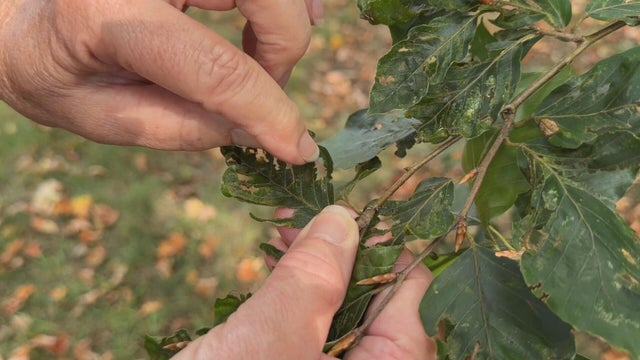Microscopic worms are attacking trees in the Northeast. Experts say Beech Leaf Disease could be devastating.
Beech Leaf Disease is spreading around the Northeast and the microscopic worms that come with it are attacking trees in Massachusetts and Rhode Island.
Arborists have been working on a potential solution to stop the disease, which cuts off photosynthesis and eventually causes trees to die.
At Château-sur-Mer, a mansion in Newport, arborists from Bartlett Tree Experts have been spraying the canopies of the century-old beech trees in a race against time.
These aren't just any trees. They're part of Newport's living history. During the Gilded Age, wealthy families filled their estates with exotic plants from around the world. The Preservation Society of Newport County now maintains those landscapes, including the towering beeches that have shaded the city for generations. But, that microscopic pest is threatening to erase them.
What is Beech Leaf Disease?
Beech Leaf Disease, first discovered in Ohio in 2012, has spread rapidly across the northeast, reaching New England in the early 2020s. The disease is caused by a tiny wormlike nematode that burrows into buds and leaves, cutting off photosynthesis. Over time, the canopy thins, the leaves crinkle, and the tree slowly dies.
Jim Donahue from the Preservation Society of Newport said the damage appeared suddenly.
"One tree would be fine, and the next tree would be suffering," he said. "There was an initial panic. What if this takes over? How long does it take for a tree to decline?"
To slow the spread, Bartlett has been treating the beeches with targeted sprays and root injections, a costly but necessary experiment.
"We don't have a magic wand," Bartlett's Daniel Brooks said. "But we're seeing encouraging results."
The fight extends beyond Newport.
Future of New England's forests
At the Ames Estate in North Easton, Massachusetts, the Trustees of Reservations are trying to save dozens of beeches across their properties. Director of Horticulture Joann Vieira walked through a grove where the damage was easy to see.
"When you look at this tree, it's still quite healthy," she said. "But in the lower canopy, the leaves are smaller, crinkled, and have lost tissue between the veins where the nematodes were doing their work."
Both organizations are spending hundreds of thousands of dollars each year to save these trees, an extraordinary price to preserve living history. That cost may sound high, but experts warn the loss could be far greater.
In New Hampshire, beech trees make up about 20% of the forest and in Maine, it's nearly half. Losing them could drastically change landscape of New England's woodlands.
"Truly devastating," Vieira said. "Beech trees are an important resource for wildlife. If they're devastated by this, there will be big openings in the forest."
Despite the challenges, Vieira said early treatments are showing promise, giving these trees a fighting chance.
"It's still an experiment, but one that could decide the future of New England's forests," she said.

